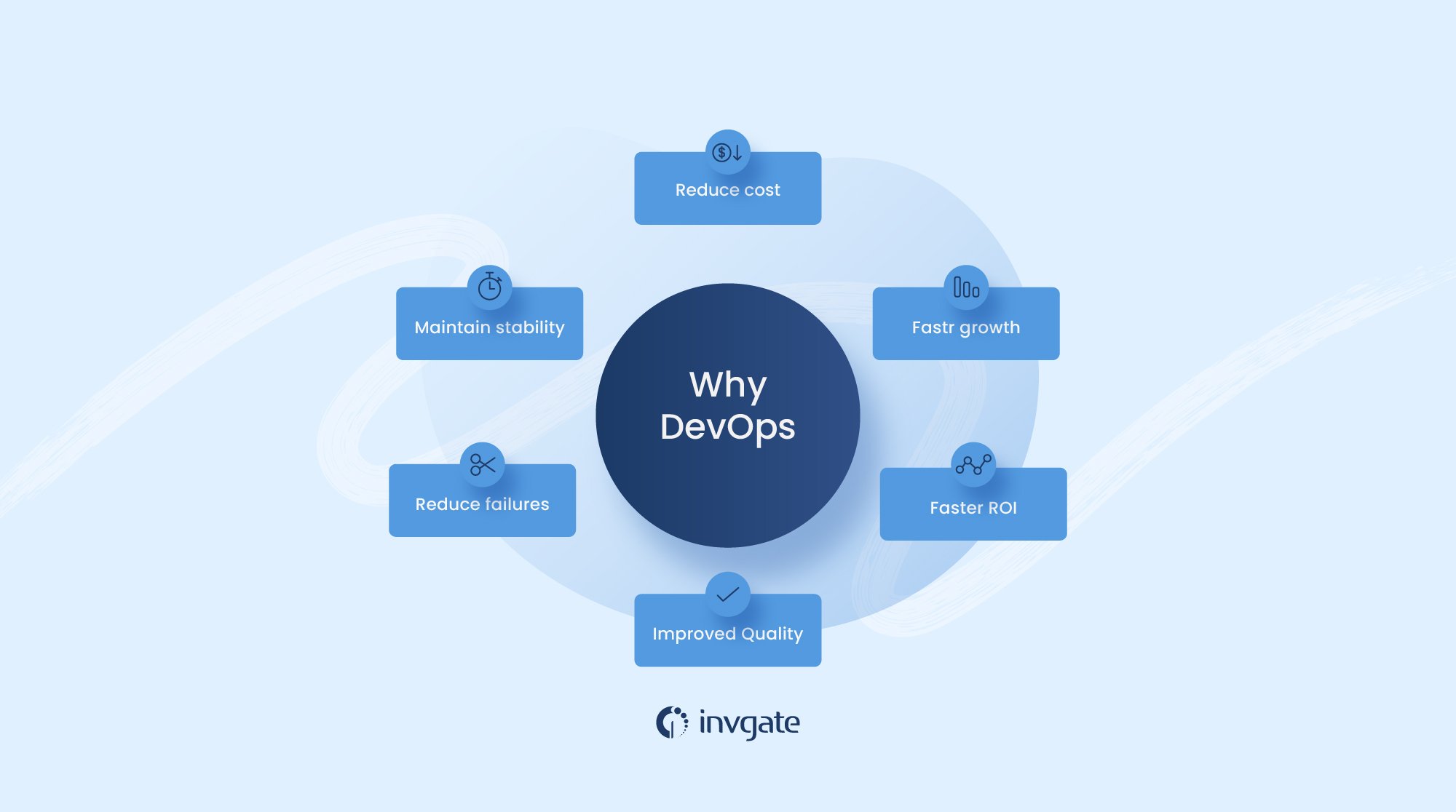If you've heard about DevOps but aren’t quite sure what it’s all about, you're in the right place. For all of its ever-increasing popularity, few can really explain what DevOps is about without tangling themselves up in jargon. DevOps can sound complicated at first, but breaking it down reveals a straightforward approach focused on collaboration, efficiency, and better teamwork.
In this article, we’ll explain DevOps, how it works, its benefits, and some best practices for getting started. Keep reading to find out why DevOps has become a core strategy for modern IT and software development teams and how it can help your organization streamline processes and respond quickly to changes.
Without further ado, here’s DevOps explained!
What is DevOps?

The goal of DevOps is to remove barriers between software developers and operations teams. Traditionally, these two groups had separate objectives—development teams focused on creating new features, while operations focused on stability and performance.
DevOps aligns the goals of both teams by promoting a culture of collaboration, shared responsibility, and continuous improvement. It aims to shorten the software development lifecycle, enabling organizations to deliver software updates, bug fixes, and new features faster and with higher quality.
According to Atlassian:
“The DevOps movement began around 2007 when the software development and IT operations communities raised concerns about the traditional software development model, where developers who wrote code worked apart from operations who deployed and supported the code. The term DevOps, a combination of the words development and operations, reflects the process of integrating these disciplines into one, continuous process.”
As you’ve just read, DevOps is not that old of a practice. But it did arise from a profound cultural and organizational need: trying to fight against fatal levels of dysfunction across the IT industry.
And what was that dysfunction, you ask? Mainly, the fact that it seemed that the software development and deployment (the ones who actually implement said software) teams were completely apart from each other. And this distance led to issues down the line that seemed to affect every part of IT operations negatively.
How does DevOps work, anyway?
DevOps tries to prevent, essentially, what’s called “organizational siloing.” In other words, it’s meant to prevent teams from working in secluded little islands that don’t interact much with each other. This fosters an environment of collaboration rather than sectarian competition and one-upmanship.
As such, DevOps teams include developers and IT teams working hand-in-hand throughout the product lifecycle. The idea is to speed up the speed and quality of not just development, but also deployment. As such, it represents a significant paradigm shift from “the way things were”. The implications for both teams and organizations are profound.
DevOps ideally prevents the organizational siloing we discussed above. In some cases, teams are merged to maximize efficiency, with engineers working throughout the product or app lifecycle. Of course, they tend to have a wider range of skills to accommodate these various scenarios. Gone are the days of engineers who had just one hyper-specialized skill and worked on it with blinders on. Now, it’s all about peripheral vision. Now, we’re in the age of interdisciplinary work.
DevOps values sometimes extend beyond software development and implementation. Good practices are good practices, after all. Security teams, for instance, can adopt DevOps modalities or even be actively integrated into the development process. When this happens, it’s an area called DevSecOps.

DevOps methodology and principles
As we mentioned, DevOps fosters collaboration between development and operations teams, bridging the gap to streamline the software delivery process.
While DevOps is often associated with specific tools and technologies, it's fundamentally a cultural philosophy. It encourages teams to adopt methodologies that enhance each stage of the software development lifecycle (SDLC).
Some of the primary DevOps principles include:
-
Team empowerment: Teams in a DevOps environment have the freedom to make decisions quickly, promoting faster innovation and minimizing bottlenecks.
-
Cross-team communication: DevOps breaks down silos, encouraging everyone involved—from developers to IT operations—to work together, aligning their goals and processes.
- Learning from Experience:
Embrace a culture of experimentation! Teams should feel free to share their wins and losses. This way, everyone can learn from each other and build a collective knowledge base that helps everyone grow. -
Small, incremental changes: DevOps encourages teams to make small, frequent updates to code rather than large, slow changes. This approach minimizes the risk of bugs and makes it easier to troubleshoot when issues arise.
Many will mention automation as central to DevOps, as it reduces repetitive tasks, minimizes errors, and ensures that code is tested, integrated, and deployed quickly and reliably. However, it is essential to view automation not as an end in itself but as a means to a greater goal: enabling teams to slow down and dedicate their time and expertise to strategic initiatives that deliver real value.
Finally, we want to mention that while there are plenty of guides, principles, and best practices out there for implementing DevOps, the real magic happens when the teams doing the work take charge of designing and developing their own processes.
The DevOps Lifecycle
From the time software is conceived, right up until the point it becomes abandonware, that’s what we call a lifecycle. Since DevOps is a continuous process, this is better represented through an infinity loop meant to convey the need for constant collaboration and iterative, lifecycle-long improvement.
From the time software is conceived, right up until the point it becomes abandonware, that’s what we call a lifecycle. And since DevOps is a continuous process, this is better represented through an infinity loop meant to convey the need for constant collaboration and iterative, lifecycle-long improvement.
The DevOps lifecycle, with its focus on continuous delivery and continuous integration, focuses on six distinct phases that facilitate these ends. Development (on the left side of the loop) has three, and operations (right side) cover the other three.
Of course, as we’ve said above, development and operations teams collaborate constantly to maintain alignment and keep things on the up and up for the duration of the process. And, of course, it behooves us to go into a little more detail about those practices.
-
Continuous integration is a software development practice where developers merge every code change they do into a single repository. It’s here where automated builds and tests are run. The goal behind this practice is to find bugs quicker and stamp out issues before they become widespread — or reach implementation in the first place. If things go well, then the time it takes to release and update software decreases significantly.
-
Continuous delivery is about implementing code changes that are automatically built, tested, and prepared for a release to production. As such, you can consider it an expansion to continuous integration, because it hinges upon deploying all code changes to a testing or production environment following the build stage. If done right, developers will have prime-time-ready builds that have already been tested adequately always at their disposal.
Now, with that out of the way, let’s take a look at all six phases sequentially in order to get a better idea of how things are laid out.
1. Planning
Improving speed and delivery is tantamount to success for DevOps teams. What’s good for that? Agile, of course. As the #1 iterative approach to project management, it’s just good practice to integrate it into DevOps planning. The way it works is by allowing teams to break down work into smaller “particles” that allow them to work at a brisker pace and deliver incremental value.
In fact, an Agile expert notes:
“DevOps can be interpreted as an outgrowth of Agile—agile software development prescribes close collaboration of customers, product management, developers, and (sometimes) QA to fill in the gaps and rapidly iterate towards a better product (...)
(...) service delivery and how the app and systems interact are a fundamental part of the value proposition to the client as well, and so the product team needs to include those concerns as a top-level item. From this perspective, DevOps is simply extending Agile principles beyond the boundaries of the code to the entire delivered service”
And speaking of code…
2. Building the code
Rapid software development and deployment are the order of the day here. Developers need to churn out new builds and updates like nobody’s business, and they need to do it following standardized testing procedures.
Different tools, like Git or Docker, can help developers construct a support system for branching and rewriting repository histories as needed. And, of course, all of this needs to happen without falling too far behind schedule. Speed and efficiency are of the essence, as is all-out effectiveness here.
3. Continuous integration and continuous delivery
When employed in tandem, continuous integration and continuous delivery allow developers to reliably produce high-quality products and keep them regularly up-to-date. In fact, this reliability and predictability allow things like source code repositories to be completely automated. They also allow teams to perform things like end-to-end testing, deploy feature flags, or merge code changes as needed.
And this is not something to take lightly either. As expert Tommy Tynja noted:
“To successfully implement continuous delivery, you need to change the culture of how an entire organization views software development efforts.”
It may be that to implement continuous integration and delivery, you have to overhaul the way you’re doing some things from the ground up. And that’s not a bad thing because when all of these tools are used together, the results can be astounding.
4. Monitor and alert
Now, just because things are working doesn’t mean you can take your hands off the steering wheel. Resolving and predicting issues should always be a priority, and that’s why you should always keep a watchful eye on everything that’s going on in a DevOps process. Remember, issues fundamentally affect product uptime, functionality, and, ultimately, speed.
But, of course, you should also be able to notify your teams of high-risk actions, changes, and failures. You know, so at the end of the day, you can keep the lights on as well. Priorities, people!
5. Operate
This is where end-to-end IT delivery comes triumphantly into the picture. Also, where you should strive to provide the best possible service to customers. And what facilitates you providing perfect service? Having an efficient reliable, well-maintained IT infrastructure that maximizes your chances of success. Everything plays into everything else.
6. Continuous feedback
Now, with DevOps, things are not a one-and-done deal. Rather, teams are meant to evaluate each release, provide detailed reports, and create the environment for future (and constant) improvement. Thus, continuous feedback enables teams to improve their processes, incorporate customer feedback, and improve all subsequent releases.

Benefits of DevOps
According to a survey by Atlassian, 99% of respondents noted organizational benefits after adopting DevOps.
But what are those benefits?
Faster, faster, faster
Speed is probably one of the most-valued metrics everywhere. If you can couple speed and efficiency, then you’re golden. DevOps is a big aid precisely in these two: do stuff faster, but better.
DevOps teams get deliverables out the door much faster, and with higher quality and stability metrics. And this, coupled with the abilities provided by continuous delivery, allows them to outperform teams that don’t use these practices by more than a hundred-fold (!!!).
Improves across-the-board collaboration
Remember the idea behind this whole thing? Right, it was to decrease siloing and foster a culture of inter-departmental and multidisciplinary collaboration. As a result, development and operations teams share the burden and responsibility of the entire process.
As a result, this increases all-around efficiency, teams can hand off work to other teams, and saves time. Plus, teams can create code that is actually relevant to the environment it’s designed for instead of doing it in near-complete isolation.
Makes deployment much faster
DevOps shines in many areas. And one of the most important is the ability to get products out faster, and improve on them continuously. And it’s not just about stability and reliability (an all-important client-side metric), but about gaining a competitive advantage by fixing bugs quickly and releasing new features when they are actually needed.

Quality and reliability
Yep, we did. Continuous integration and delivery also help software developers ensure changes that are functional and safe, which improves overall product quality. Plus, monitoring helps teams stay on top of software performance at all times. This ensures even better results than normal, and a culture of constant improvement.
Security
This is an area where DevOps overlaps with ITIL. In our article about how to build a culture of cybersecurity, we said:
“An organization’s culture defines how employees conduct themselves in their work environment, whether in an office or work-from-home situation. It dictates how employees communicate, the boundaries, the way they dress or present themselves, and what’s expected of every employee. A cybersecurity culture attempts to reduce the overall cybersecurity risk by strengthening an organization’s weakest link and its most valuable resource: its people.”
By integrating security into continuous integration, continuous development, and continuous deployment, DevSecOps becomes an all-important part of the development process. In fact, it builds security features right into products, and reinforces this by enforcing regular security audits and testing — all within DevOps workflows and agile development guidelines.

DevOps tools and technologies
Although DevOps is not about tools and processes, and teams can implement DevOps without any tooling whatsoever, you'll find that it's still very common to talk about "DevOps tools."
That's because DevOps-enabled teams tend to use every tool at their disposal to automate and facilitate processes. This gives them more time to utilize their skills where they are needed, aligning with the principle of maximizing human effort where it is most impactful. And, as a much-needed plus, they don’t just accelerate processes but also make them much less prone to errors.
The right toolchain also makes it easier for DevOps teams to follow some of their fundamentals, such as continuous integration, continuous delivery, automation, and collaboration, which are the order of the day here.
-
Code repositories (e.g., GitHub, GitLab, Bitbucket): These platforms allow teams to manage, track, and control code versions effectively.
-
Artifact repositories (e.g., Nexus, Artifactory): Storing compiled binaries, libraries, and other build artifacts in repositories ensures efficient code reuse and streamlined deployment processes. These repositories help DevOps teams manage dependencies and enhance the consistency of builds across environments.
-
Continuous Integration/Continuous Delivery (CI/CD) Tools (e.g., Jenkins, CircleCI, GitLab CI/CD): CI/CD engines are crucial for automating the integration, testing, and deployment of code. By running code through automated checks, these tools speed up delivery cycles, catch issues earlier, and provide constant feedback to developers, reducing bottlenecks.
-
Containers and container orchestration (e.g., Docker, Kubernetes): Containers package code and dependencies, allowing for consistent deployment across environments.
-
Configuration management (e.g., Ansible, Puppet, Chef): Configuration management tools automate the setup, deployment, and scaling of infrastructure.
-
Monitoring and logging (e.g., Prometheus, Grafana, ELK Stack): Monitoring tools monitor application performance and identify issues while logging solutions provide insights into system events.

What are the challenges of adopting DevOps?
While DevOps offers many advantages, transitioning to a DevOps model comes with its own set of challenges:
-
Cultural shift: Adopting DevOps requires a significant change in mindset and company culture. Teams used to working in silos may find it difficult to adapt to the collaborative, shared-responsibility approach of DevOps.
-
Skill gaps: Many organizations may find that their teams lack the skills needed to fully implement DevOps practices. A DevOps engineer requires knowledge of both development and operations, as well as expertise in automation, cloud platforms, and modern testing techniques. Addressing skill gaps may require hiring, training, or upskilling existing staff.
-
Change Management: DevOps requires teams to embrace change and continuously improve their processes. For organizations used to traditional models, it can be challenging to adopt a continuous, iterative approach to development, testing, and deployment.
-
Measuring success: Since DevOps emphasizes continuous improvement, it’s often challenging to measure success. Organizations need to establish clear metrics to track the impact of DevOps practices, such as release frequency, defect rates, and mean time to recovery (MTTR).
Overcoming these challenges typically involves strong leadership, adequate training, and a commitment to continuous learning and adaptation. While the initial transition can be demanding, the long-term benefits of adopting a DevOps culture — faster delivery times, increased software quality, and greater flexibility — often outweigh the challenges.

DevOps best practices
When adopting DevOps, having a clear strategy can make the transition smoother and the results more impactful. Here are a few practices to keep your DevOps team on track and focused on continuous improvement.
-
Start small with a pilot project: Begin with a manageable project rather than trying to overhaul everything at once. Select a project that can benefit from faster delivery and more efficient operations. This approach allows you to test the waters, make adjustments, and see quick wins that can help build momentum and buy-in across the organization.
-
Select the right tools for your workflows: DevOps isn’t about using a specific set of tools; it’s about choosing tools that fit your needs. Look for options that support automation, integration, and collaboration. Tools like Jenkins, GitLab, or Docker are popular, but the right toolset should align with your team’s workflows and the unique needs of your organization.
-
Use meaningful metrics to track progress: Avoid vanity metrics and focus on measurements that genuinely reflect the efficiency and quality of your processes. Metrics like deployment frequency, lead time for changes, and mean time to recovery (MTTR) offers insights into how well DevOps is working. These numbers give you real visibility into the impact of changes and the health of your delivery pipeline.
-
Assess progress with the DevOps maturity model: The DevOps maturity model provides a framework for evaluating where your organization stands in its DevOps journey. The model helps teams measure their effectiveness in key areas like collaboration, automation, and culture.
-
Adopt a DevOps culture of collaboration and communication: DevOps isn’t just about tools and automation—it’s a cultural shift that involves breaking down silos and fostering transparency between development, operations, and even other teams like QA and security. DevOps engineers must be able to work collaboratively and communicate effectively with other teams. Encourage open communication, regular feedback loops, and shared goals to promote a truly collaborative environment.
-
Automate where it makes sense: Automation is a powerful aspect of DevOps, but automating every single task isn’t always practical, and it isn't the main goal of DevOps. Start with repetitive, high-impact tasks like testing and deployments. Over time, look for additional automation opportunities to streamline your processes, improve efficiency, and free up your team for more strategic work.

Final words
If you want to prevent organization siloing and get software out quicker, more reliably, and more in tune with real-world usage, then DevOps is for you. And, considering its absolutely amazing track record, we would recommend you start implementing it.
As Gene Kim put it:
"DevOps and its resulting technical, architectural, and cultural practices represent a convergence of many philosophical and management movements (including): Lean, Theory of Constraints, Toyota production system, resilience engineering, learning organizations, safety culture, Human factors, high-trust management cultures, servant leadership, organizational change management, and Agile methods.”
And, as such, it’s the perfectly potent cocktail to help propel your software development and operations efforts into a well-oiled machine that operates as a whole.
The easiest way to get started with DevOps is to identify a small value stream and start experimenting with some DevOps practices. So, we want to close with a final piece of advice: start small, be patient, and be willing to learn and adapt.















